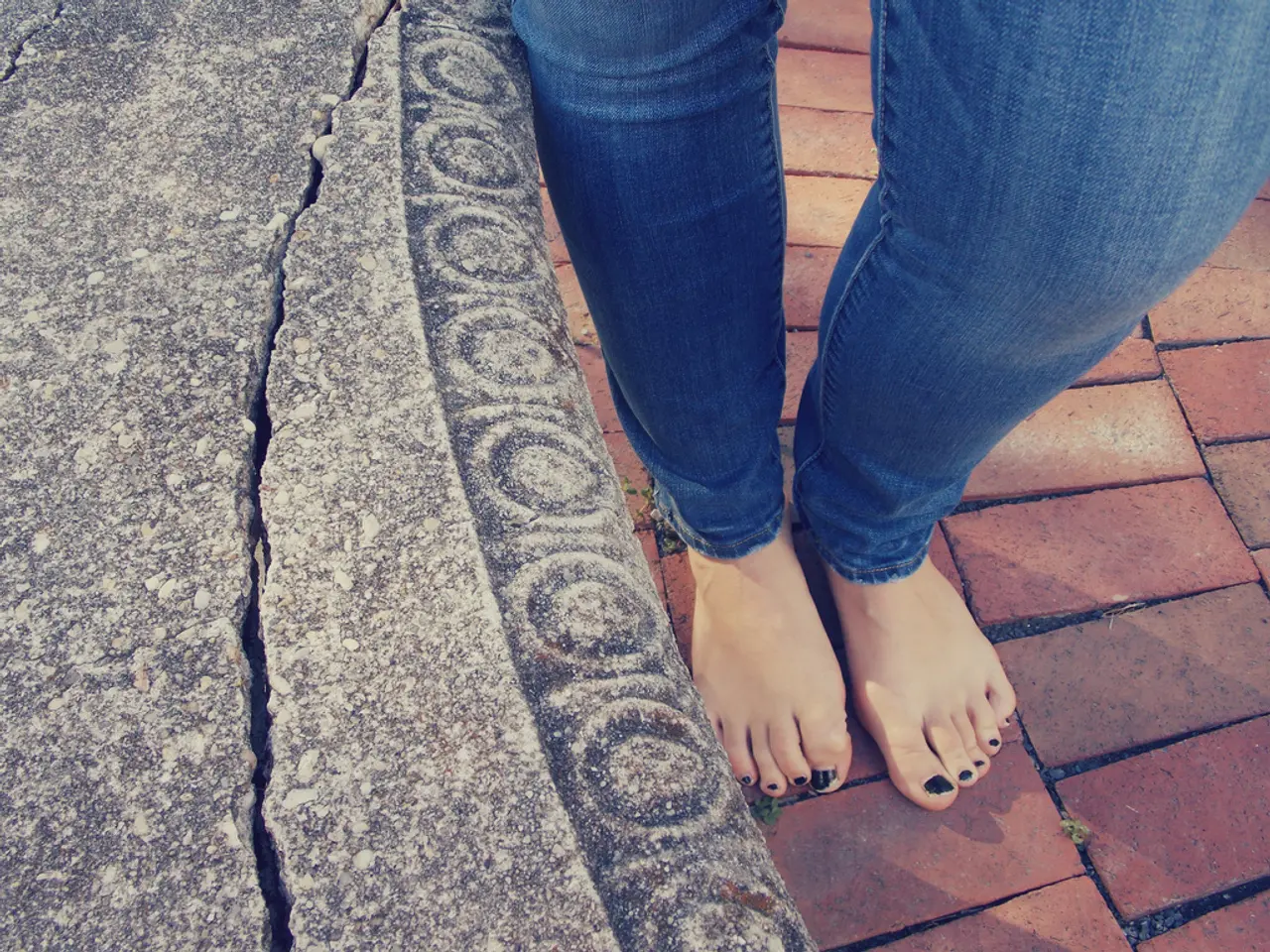Circulatory Issues: Symptoms, Causes, Remedies, and Further Insights
Poor circulation, a condition where the circulatory system fails to pump blood effectively to all parts of the body, can lead to a drop in blood, oxygen, and nutrient delivery to affected areas. This can result in a range of symptoms, including numbness or tingling in the limbs, particularly the feet and hands, pain, muscle cramps, slow-healing wounds or ulcers, cold or discolored extremities, visible bulging veins or varicose veins, and noticeable temperature differences between limbs [1][2][3][4].
Various conditions can cause poor circulation. Peripheral Artery Disease (PAD), a common cause, occurs when plaque builds up in the arteries, narrowing them and restricting blood flow. This condition is associated with high cholesterol, diabetes, hypertension, and smoking [1][2][3][5]. Diabetes, in particular, can lead to blood vessel damage and poor microcirculation, especially in the feet and hands [1][2][3][5].
Other causes of poor circulation include Raynaud’s Disease, which causes spasms in smaller arteries, limiting blood flow during cold or stress; vitamin B-12 deficiency, which can cause neurological symptoms and poor circulation; and blood clots or varicose veins [1][2][3][5]. A sedentary lifestyle can also contribute to circulatory problems by causing fat buildups in the arteries and increasing the risk of developing circulatory health conditions, including heart disease, high blood pressure, and atherosclerosis [1][2][3].
Treatment for poor circulation depends on the underlying cause but generally includes lifestyle changes such as regular exercise, a healthy diet, and quitting smoking. Medications may also be prescribed to reduce plaque buildup and blood clots, improve circulation, and widen blood vessels [1][2][3][5]. Compression therapy, such as compression socks or bandages, can help improve venous return.
In more severe cases, surgical or minimally invasive procedures like angioplasty, atherectomy, and stent placement may be necessary to keep arteries open [1][2][3][5]. Novel non-invasive therapies like D’OXYVA, which improves microcirculation by triggering vasodilation and enhancing oxygen delivery to tissues, are also available [1][2][3][5]. Vitamin supplementation, such as for vitamin B-12 deficiencies, can also be effective [1][2][3].
Consultation with healthcare professionals such as podiatrists or vascular specialists is important to determine personalized treatment plans and to address complications like wounds or ulcers [1][2][3][5]. A diagnosis of poor circulation will consider a person's symptoms, risk factors, related conditions, family medical history, and the results of a physical examination, and may include blood sugar testing, blood tests to detect inflammatory conditions, ultrasound or CT imaging, an ankle-brachial index, and other tests to examine the blood vessels and check for clots [1][2][3].
It is crucial to manage and reduce risk factors for PAD, such as smoking, diabetes, and high cholesterol, to prevent long-term complications. Maintaining a moderate weight and leading an active lifestyle can significantly improve circulation and overall health.
In conclusion, poor circulation can manifest with various symptoms and is often caused by arterial disease, diabetes, or vascular conditions. Treatment ranges from lifestyle modifications and medications to surgical interventions and novel therapies like D’OXYVA. Regular check-ups with healthcare professionals are essential to monitor circulation health and address any issues promptly.
References: [1] Mayo Clinic. (2021). Peripheral artery disease (PAD). Retrieved from https://www.mayoclinic.org/diseases-conditions/peripheral-artery-disease/symptoms-causes/syc-20369673 [2] National Heart, Lung, and Blood Institute. (2021). Peripheral arterial disease (PAD). Retrieved from https://www.nhlbi.nih.gov/health-topics/peripheral-arterial-disease [3] American Heart Association. (2021). Peripheral artery disease (PAD). Retrieved from https://www.heart.org/en/health-topics/peripheral-artery-disease [4] Cleveland Clinic. (2021). Peripheral artery disease (PAD). Retrieved from https://my.clevelandclinic.org/health/diseases/11676-peripheral-artery-disease [5] WebMD. (2021). Peripheral Artery Disease (PAD). Retrieved from https://www.webmd.com/heart-disease/peripheral-artery-disease-pad
- Hemophilia, a genetic disorder that causes the body to not produce enough clotting factors, can lead to prolonged bleeding and poor circulation.
- Ulcerative colitis, a type of inflammatory bowel disease, can cause reduced blood flow to the colon and contribute to poor circulation.
- Multiple sclerosis, a chronic disease that affects the brain and spinal cord, can lead to impaired blood flow and low oxygen levels in the affected areas.
- Science has been working to develop predictive models for COPD, a chronic lung disease, to manage the progression and related poor circulation issues.
- In the workplace-wellness programs, emphasis is placed on recognizing and managing various medical conditions, such as obesity, diabetes, and chronic diseases, that can cause poor circulation.
- Health-and-wellness campaigns often promote fitness-and-exercise routines to improve blood flow and circulation, thus reducing the risk of developing circulatory health problems.
- Mental health, like depression, can impact an individual's motivation level, lifestyle choices, and overall well-being, potentially leading to poor circulation and other chronic diseases.
- Skin-care regimens should be tailored to an individual's specific needs according to their skin type and any existing medical conditions, such as poor circulation.
- There are multiple therapies-and-treatments for poor circulation, including CBD oil and its potential blood flow improvement properties for conditions like Raynaud's Disease.
- Proper nutrition is crucial to maintaining a healthy circulatory system and reducing the risk of developing circulatory problems, such as atherosclerosis.
- Sports participation can raise awareness of the importance of maintaining good circulation for optimal athletic performance, as well as overall health and wellness.
- Sports analysis can reveal patterns and risk factors associated with poor circulation in athletes and encourage preventive measures like fitness-and-exercise routines.
- In addition to lifestyle changes, novel treatments like nutrition and CBD therapies can complement traditional approaches, such as medications and surgeries, for managing and improving poor circulation.




